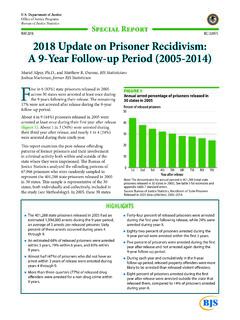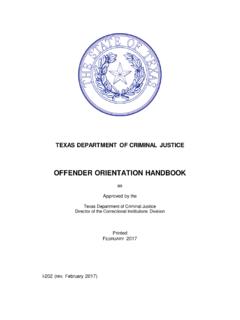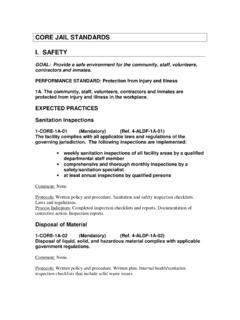Transcription of Education and Correctional Populations
1 By Caroline Wolf Harlow, StatisticianAbout 41% of inmates in the Nation sState and Federal prisons and localjails in 1997 and 31% of probationershad not completed high school or itsequivalent. In comparison, 18% of thegeneral population age 18 or older hadnot finished the 12th 1991 and 1997, the percentof inmates in State prison without ahigh school diploma or GED remainedthe same 40% in 1997 and 41% in1991. Of inmates in State prisons,293,000 in 1991 and 420,600 in 1997had entered prison without a highschool diploma, a 44% 9 in 10 State prisons providededucational programs for their of State prison inmates reportedthey had participated in an educationalprogram since their most recent admis-sion to prison.
2 About a quarter of Stateinmates had taken basic Education orhigh school level courses, and almost a third, vocational training. Data for this report were taken from theSurvey of Inmates in State and FederalCorrectional Facilities, 1997 and 1991,the Survey of Inmates in Local Jails,1996 and 1989, and the Survey ofAdults on Probation, 1995, sponsoredby the Bureau of Justice Statistics(BJS), the Current Population Survey,1997, sponsored by the Bureau of! 19% of State prison inmates, 10%of Federal inmates, and 16% of thosein local jails and on probation hadbeen physically or sexually abusedbefore their most recent admission toa Correctional population.
3 ! A third of women in State prison, asixth in Federal prison, and a quarterin jail said they had been 3-6% reported that someonehad tried to rape them but had notsucceeded.! 9 in 10 knew their abuser.! 9 in 10 abused men and women inState prison had used illegal of the men and 80% of thewomen used them regularly.! Two thirds had been injured in afight or assault. 68% of State prison inmates did notreceive a high school diploma. About 26% of State prison inmatessaid they had completed the GEDwhile serving time in a correctionalfacility.
4 The groups of State prison inmateswho had not completed high school or the GED included 40% of males and 42% of females27% of whites, 44% of blacks,and 53% of Hispanics52% of inmates 24 or youngerand 35% of inmates 45 or older61% of noncitizens and 38% of citizens59% with a speech disability, 66% with a learning disability, and37% without a reported disability47% of drug offenders12% of those with military serviceand 44% with no military service. Although the percentage of Stateprison inmates who reported takingeducation courses while confined fellfrom 57% in 1991 to 52% in 1997, thenumber who had participated in aneducational program since admissionincreased from 402,500 inmates in1991 to 550,000 in 1997.
5 The following groups of State prisoninmates had participated in an educa-tional program since their most recentadmission to prison:54% without a high schooldiploma, 60% with a GED, 42% with a high school diploma, and43% with postsecondary education52% of males and 50% of females49% of whites, 54% of blacks,and 53% of Hispanics58% who were 24 or younger and 47% of those 45 or older54% of noncitizens and 52% of citizens. Not school high school or lesspopulationtionersinmateseralStatecer atedEducational attainmentGeneralProba-Local jailFed-incar-Prison inmatesTotal Educational attainment for Correctional Populations and the generalpopulationBureau of Justice StatisticsSpecial Department of JusticeOffice of Justice ProgramsRevised 4/15/03 thEducation and CorrectionalPopulations January 2003, NCJ 195670 Labor Statistics, and the National AdultLiteracy Survey, 1992.
6 Sponsored bythe National Center for EducationalStatistics. In personal interviews with nationallyrepresentative samples of inmates inState and Federal prisons and localjails and of persons on probation,respondents were asked about pasteducational achievements and recenteducational experiences, as well asabout their offenses, criminal history,and other characteristics. The National Adult Literacy Survey,another personal interview survey,assessed the literacy levels of personsin the general population and includeda short questionnaire about personalcharacteristics, including educationalattainment.
7 The Current Population Survey (CPS)primarily collects monthly data on laborforce participation from a nationallyrepresentative sample of the civiliannoninstitutional population. In March ofeach year the CPS also collectsadditional information, including educa-tional attainment. In addition, some information oneducational programs conducted in Correctional settings from the BJSC ensus of Local Jails, 1999, and theBJS Census of State and Federal AdultCorrectional Facilities, 2000 and 1995,has been used. (See Methodology for further information on these data.)
8 Correctional Populations lesseducated than the generalpopulationCorrectional Populations includingState and Federal prison inmates, localjail inmates, and probationers differsubstantially in educational attainmentfrom persons 18 and older in thegeneral civilian noninstitutional popula-tion. Correctional Populations report lowereducational attainment than do those in the general population. An estimated40% of State prison inmates, 27% ofFederal inmates, 47% of inmates inlocal jails, and 31% of those servingprobation sentences had not com-pleted high school or its equivalentwhile about 18% of the general popula-tion failed to attain high school gradua-tion (table 1).
9 Persons in Correctional populationswere more likely than those in thegeneral population to have passed a test which indicates the same level ofknowledge as those with a high schooldiploma. The Center for Adult Learningand Educational Credentials of theAmerican Council on Education devel-ops the General Educational Develop-ment (GED) test for persons who arenot enrolled in a school. The testassesses academic skills and knowl-edge expected of high school gradu-ates. Employers and educational insti-tutions usually accept the GED as theequivalent of a high school diploma.
10 For a quarter of State prison inmates, a fifth of Federal inmates, a seventh of jail inmates, and a tenth of proba-tioners, as for about 4% of the generalpopulation,* passing the GED testingprocess was the highest level of Education they attained. Participation in college-level courses or post-secondary vocational classeswas less common for those in correc-tional Populations than for persons inthe general population. An estimated11% of State prison inmates, 24% ofFederal inmates, 14% of jail inmates,and 24% of probationers attendedsome college or other postsecondaryinstitution compared to 48% in thegeneral 4/15/03 th2 Education and Correctional Populations Sources: BJS, Survey of Inmates in State and Federal Correctional Facilities, 1997 and 1991; BJS, Survey of Inmates in Local Jails, 1996 and1989; BJS, Survey of Adults on Probation, 1995.
















